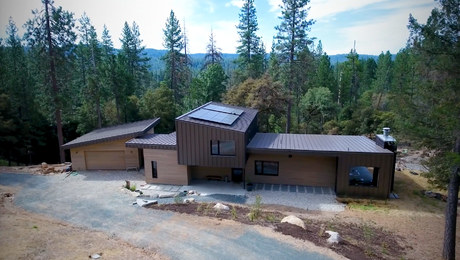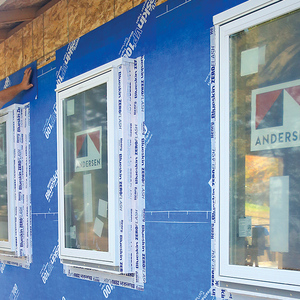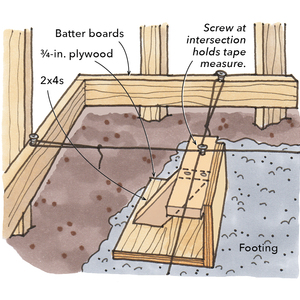hello all, I am a resident of the great cold northcountry that is Duluth, Minnesota. i am about to start a remodel of an old kitchen, and part of the project has me installing new countertops. one of the features of the new kitchen i’ve designed is to have an integral butcher block beside the slide-in range surface. it is rather basic… just cutting out an 18″x18″ portion of the countertop, and sliding in a piece of custom cut butcher block. what i am looking for is some advice on is what to to close off the interface/joint between the two surfaces with so that food and other pieces of unwanted material don’t fall through the joint? i’ve thought of running a bead of clear caulk along the surface, then just tooling it smooth with my finger, but that didn’t seem like a very finished look. i’ve also thought about running a little piece of “T” shaped stainless steel around the joint with the vertical portion extending down into the joint and the horizontal portion bridging between the countertop and butcher block to close off the joint, but I’d rather keep the surface b/w the counter and butcher block smooth. anyone out there have any suggestions? thanks.
Discussion Forum
Discussion Forum
Up Next
Video Shorts
Featured Story

Look closely at these common locations for hazardous materials in older homes.
Highlights
"I have learned so much thanks to the searchable articles on the FHB website. I can confidently say that I expect to be a life-long subscriber." - M.K.
Fine Homebuilding Magazine
- Home Group
- Antique Trader
- Arts & Crafts Homes
- Bank Note Reporter
- Cabin Life
- Cuisine at Home
- Fine Gardening
- Fine Woodworking
- Green Building Advisor
- Garden Gate
- Horticulture
- Keep Craft Alive
- Log Home Living
- Military Trader/Vehicles
- Numismatic News
- Numismaster
- Old Cars Weekly
- Old House Journal
- Period Homes
- Popular Woodworking
- Script
- ShopNotes
- Sports Collectors Digest
- Threads
- Timber Home Living
- Traditional Building
- Woodsmith
- World Coin News
- Writer's Digest


















Replies
It wouldn't be completely flush, but how about screwing an anodized alum. angle to edges of cutting board, flange facing out? It could hang into opening. If you mitered corners on say, a 1/2x1/2x1/16" angle, it would stick up 1/16". Hole in counter wouldn't have to be as clean because you cover it. Also it would be removable for cleaning.
Don't like the idea of a little silicone scrap in my sliced tomatoes!
PJ
Whatever you can do or dream you can,
Begin it
Boldness has genius, power, and magic in it. Goethe
Is the butcher block going to be flush or proud of the adjacent countertop?
Usually they're proud.
If proud, make the butcher block with a rabbet milled on the bottom sides.
This way the butcher block will "sit on" and overlap the adjacent countertop, and you'll have a tight seam all around. You can sandwich a bead of silicone between the countertop and the butcherblock when you install the butcherblock for added protection. Any squeeze out can be scraped away flr a clean joint.
Don't know what your substrate for this countertop will be, but I'd be certain to get a couple good coats of varnish on the cut edges so that liquids don't get absorbed.
As far as the joint seam in question, I am initally thinking along the same lines as Mongo. Only I would alter his suggestion a bit. Instead of a bead of silicone, I'd think about milling a narrow groove around the underside perimeter and then putting a gasket in there. Something like screen spline squeezed into the groove.
If your counter and BB are both flat and the gasket material of the right size, this would also prevent liquids from getting under the edges of the board........and still allow for easy removal to take the board to the sink for cleaning.
You haven't said whether this will be true butcher bock (end-grain up) or just an edge-laminated piece. Either will expand and contract with changes in humidity and must be provided for and allowed to do so. There might be some tendency for either style to cup or twist a bit when wet and that could confound your attempts to use a gasket (or maybe even caulk).......unless the gasket is a bit larger in diameter and of a soft enough material to conform to the counter under just the weight of the board.
I'm thinking that a naturally oily wood might serve you best as it wouldn't be as inclined to suck up water and other liquids. Teak, maybe?
Knowledge is power, but only if applied in a timely fashion.
Edited 1/5/2005 6:25 pm ET by GOLDHILLER
I second the concern about seasonal expansion. I have a 6" thick maple end-grain block set in a granite slab- and it move an average of 3/8" over the course of a year. Every method I tried to seal it to the stone has failed. Since the block is free floating, I now just move it occasionally to clean the crud out, and keep it oiled on all sides with mineral oil for protection.
It is a gorgeous functional piece- but what a pain in the a$$!
=====Zippy=====
Thanks all for the suggestions. To clarify a bit: the BB material is 1" th. maple end grain, and the countertop material is laminate with a particlebd substrate. Initially, I like the suggestions of MONGO and GOLDHILLER, to notch the edge of the block and set it in slightly proud of the countertop and use a screen-spline type of material as a gasket. Boy, as ZIPPY-ZOOM said though, in the end it sounds like a pain with the differential expansion and housekeeping issues. To have it set into countertop opening would really be a nice detail, but boy oh boy, in the end I'm not sure the best option wouldn't just be to forget recessing it into the countertop and instead just having a piece of loose BB material just sitting loose, directly ontop of the countertop. That just doesn't have the same neat detail to it though. What do you all think?
I don't think a built in cutting board can be kept truly sanitized unless you are willing to bleach it after every use. I much prefer one i can toss into the sink and scour down. I just had this conversation with my wife - we are expanding an island and thought a big BB section in the middle would be neat - but both agreed it would be a pain.
Just my opinion ... Bill.
What about the idea of attaching some "stops" directly to the top of the countertop material that would hold a loose piece of BB? Hard to explain, but basically set the BB on the coutertop, then flush along each of the 4 sides place a "bumper" or "stop" of some sort to hold the block in place. Or I suppose a blind/hidden stop system could also be installed on the underside by running a 1/4" groove along the bottom of the BB, about 1" to the inside of each edge, that would corresponded to 4 stops that would mate to the grooves.....place the BB ontop and it would be solid against any lateral movement, but still easily removeable and yet out of sight.
I think it's a matter of personal preference. I'm sure that would work fine ... I actually like the white plastic cutting boards (wood is not allowed in restaurants anymore because of sanitation issues). They can go right into the dishwasher. Apparently the trend now is to get them color coded - one color for veggies, one for chicken, etc, so you never cross contaminate. I'm not that fanatic (yet). I've also seen a trend for these very thin sheets of plastic that you unroll directly onto the counter - same deal - color coded, go directly into the dishwasher.
All that said, I love the look of a big honking slab of butcher block in a kitchen. My mother runs a commercial bakery and has a huge (5'x20') butcher block table - it looks awesome. Then she pulls out the plastic cutting boards - food never touches the wood!
Bill.
Regarding the germ issues: I read a rather comprehensive study recently (sorry, I can't reference where) of wood vs. plastic cutting boards and the conclusion was quite interesting.The study found that wood (edge laminated, not end grain) did absorb more germs than plastic, but was less likely to release the germs than plastic. Apparently both materials, once used enough to have lots of grooves, hold germs down in the grooves that don't come out with normal cleaning. After cleaning, the plastic easily contaminated the next objects to be cut on the cutting board, but the wood did not. The wood basically absorbs the germs and doesn't allow them to be released during later use.-Rich
What about the idea of attaching some "stops" directly to the top of the countertop material that would hold a loose piece of BB?
That's where my thinking was going. Drill counter top and BB for a nice stout dowel--say 3/8" around. Put the dowels in the BB, though. That way the board will stand proud of what ever surface it's on after washing (and you should always be able to move the board to the sink to wash it properly, in my book).
Now, to make the countertop nice, you could get some 3/8" ID copper end caps, and set those into the counter top, with a nice WP epoxy, to take the dowels on the BB. That way, you don't have the "raw" PB exposed, and you get a nice finished look.
I'd drag my flaring tool out to just ease the "top" edge of the cap--but some judicious filing or dremel-tooling might be better. Chamfering the ends of the BB dowels would no go amiss, either, I'm thinking.
You could go with 1/2" as that would make cleaning the countertop "holes" a hair easier--but at the extra hassle with bigger dowels in the BB.
Edit to point out that I just use the open-web shelf cloth to "stick" the boards down on my counters. I bought a roll for $3 something about 5 years ago, and just used it up before Christmas (when the cloth gets messy or needs cleaning, it just goes in the bin). It comes in colors, too, in case the decorating committee so decrees.
Occupational hazard of my occupation not being around (sorry Bubba)
Edited 1/6/2005 2:59 pm ET by CapnMac
wood has natural anti bacterial properties. There was a study published in JLC amoung other places about a year ago investigating the same assumption you make. It turned out that the plastics commonly used for cutting boards are more likely to harbour kitchen bacterium than maole is.
Welcome to the Taunton University of Knowledge FHB Campus at Breaktime. where ... Excellence is its own reward!
Piffin - I don't doubt your data, but my comments were based on health dept requirements for commercial kitchens in MA, plus my foggy memory of a Fine Cooking article on the subject.
Someone mentioned the way plastic will, over time, develop grooves from cutting and start to trap more bacteria - at that point, because it's so cheap, you could toss it and replace it.
As I said earlier, I love the look of a BB counter, but wouldn't do one myself.
Bill.
Simple expansion of the board would be really easy to provide for with a rabbeted drop-in piece.Simply make sure that the shoulders of the rabbet are dimensioned such that the piece has "slop" in it when it sets in the countertop. Enough slop to provide for the maximum amount of expansion it would incur.Now it's only the potential for cupping or warping that becomes a further consideration. If the arrangement is done such that he bottom of this board also has access to atmospheric air changes, you've just helped immensely. Tell your client that the board should be kept well-oiled and not allowed to become saturated and left that way for long periods of time....and you'll likley get away with it just fine......particularly if this board is laminated from long narow strips instead of end-grain up little blocks. End-grain up would encourage sucking up liquids and consequently be more prone to cup and warp potential.You could even make two boards while you're at it. They could be swapped out while one is allowed to dry down if it becomes cupped or warped from saturation.Maybe even backer rod could be used for a gasket if you need a thicker one. Whatever gasket material would be used, it should be fastened such that renewal of itself is pretty easily done. And I'd be inclined to buy plenty of the chosen gasket material, lest that particular material should become unavailable at some time in the future. Knowledge is power, but only if applied in a timely fashion.
The particle board substrate is a concern. You don't want that getting wet.
Either rabbet the bottom of the butcher block with a slight oversize to allow for movement, and add a bead of silicon that will be sandwiched (and invisible) between the insert and the countertop, and permanently mount the butcherblock...
...or just have the block sit on top of the countertop so it can be moved/stored as required.
With the particleboard I really woundn't want this thing to be removeable.
If not mounting it permanently, to make a it easier to work with, have a lip on the front edge of the butcherblock. The lip hangs over the edge of and catches on the edge of the countertop so when you use it, the butcherblock doesn't slide all over the place. Sorta the same idea as a 3/4" thick cabinet shelf with a 2" wide face frame piece of trim on the front edge of the shelf, resulting in a 1-1/4" lip. Hope that makes sense.
End grain is perfectly appropriate for most food prep, but you might want to have a slab of plastic for cutting meat/poultry, etc.
My wife is a food science freak and restauranteur and is anal about hygeine, and in our house we have a kitchen full of wood countertops. Both end- and edge-grain.
I don't believe that a piece that small would have noticeable expansion if you seal the ends with oil well.this whole idea is amusing to me because I have a customer with new BB top who wants to be sure to get a trivet to keep hot pots aaay from it near the range
Welcome to the Taunton University of Knowledge FHB Campus at Breaktime. where ... Excellence is its own reward!
Sorry, but I gotta disagree this time. Darn seldom I get a chance to do that. ;-) Oil doesn't really make for much of a vapor barrier and that 18" piece would move appreciably from changes in RH alone unless the RH of the house is darn stable.Add any absorbed juices and/or water and you'll have substantially more potential for movement......and for warp cause that's gonna take place mostly or entirely on one side.Just how much problem all of this would be, will be somewhat dependant upon the HO's kitchen habits......both those concerning use of the board and the care of it. But differences in RH will strike for sure and must be allowed for.http://www.woodbin.com/calcs/shrinkulator.htmKnowledge is power, but only if applied in a timely fashion.
We had a section of butcher block counter top in an old house - several houses back. It's a nice idea, but the reality of it is that they get nasty dirty, require maintenance, and the only real fix I found was to sand the thing down occasionally and re oil it - in short refinish it. I much prefer something that can be put in the dishwasher. Matt
OK, the shrinlalator says that this 18" piece could move as much as 3/4" in the extreme.But in the real world, I rarely see wood move more than a third of the calculated allowance. That means 1/4" is about all. Then seal the end grains and reduce it to 1/8", maybe 3/16" Maybe you are right. I don't do any endgrain BB, just the lineal, but my experience just doesn't have more than 1/8 to 1//4" movement in all the 25" tops I've worked with. That is marginal and almost never noticeable.
Welcome to the Taunton University of Knowledge FHB Campus at Breaktime. where ... Excellence is its own reward!
Yup. I'd agree with those lower figures. Appears we really don't have a disagreement here.I guess what I'm trying to say is even those low figures have to be accounted for during the design and construction of the arrangement, if it's being let-in to the countertop…..; presented as one method. If installed tightly or without quite enough room for this expansion, troubles will follow.Alternately, if any other method is used that would constrain movement……..same deal….whether that method would constrain shrink or expansion. On the subject of an HO's habits with a wood cutting board or countertop……I had clients some years back for whom I made maple counters. They were sure this is what they wanted and were counseled about care, use, etc. And so in the counters went. Custom made. Oh, were they ever pleased!! One final counsel and then with check in hand, I made for home. Stopped by a couple days later to pick up the last of the tools and equipment that were left in their garage. Guy has me step in to see a problem with one of their antique chairs. As we pass thru the kitchen, my eyes gaze toward the counter…..the entirety of the one 10' section is now saturated in much milk and tomato juice!! They were canning tomatoes all day and the night before had removed a gallon jug of frozen milk from the freezer, placing it on the counter to thaw over night. Duh. What no sink here? Anyway, the jug had split near its bottom during the freeze and so leaked when it thawed. It was now 3 PM or so the following afternoon and they hadn't bothered to move the jug or mop it up yet. Nor off the floor where the excess had run. Arrrrrrrrrrrrrrrgh. Knowledge is power, but only if applied in a timely fashion.
I loved the idea of the lippped lay-in.I see the same thing all the time. Slobs who can't even close a cabinet door or drawer will pay sixty grand for a gleaming kitchen.Why?
Welcome to the Taunton University of Knowledge FHB Campus at Breaktime. where ... Excellence is its own reward!
"I loved the idea of the lippped lay-in"Mongo was first with that, IIRC.Faster to the post button. <g>Or.......they'll pay 60Gs for a kitchen that isn't anything but eye-candy for guests. Might make a pot of coffee once in a while, but that's it.Must have too much money. We'll do what we can to help them out, eh? LOLKnowledge is power, but only if applied in a timely fashion.
MNS,
Good advice from all. My 2 cents, ....Make the board removable. 18" sq should not be all that big of a big deal to clean removed in ones sink.
I actually made my 72"x30"x2.250" block removable for that very reason. Trust me, you got it easy.
WSJ